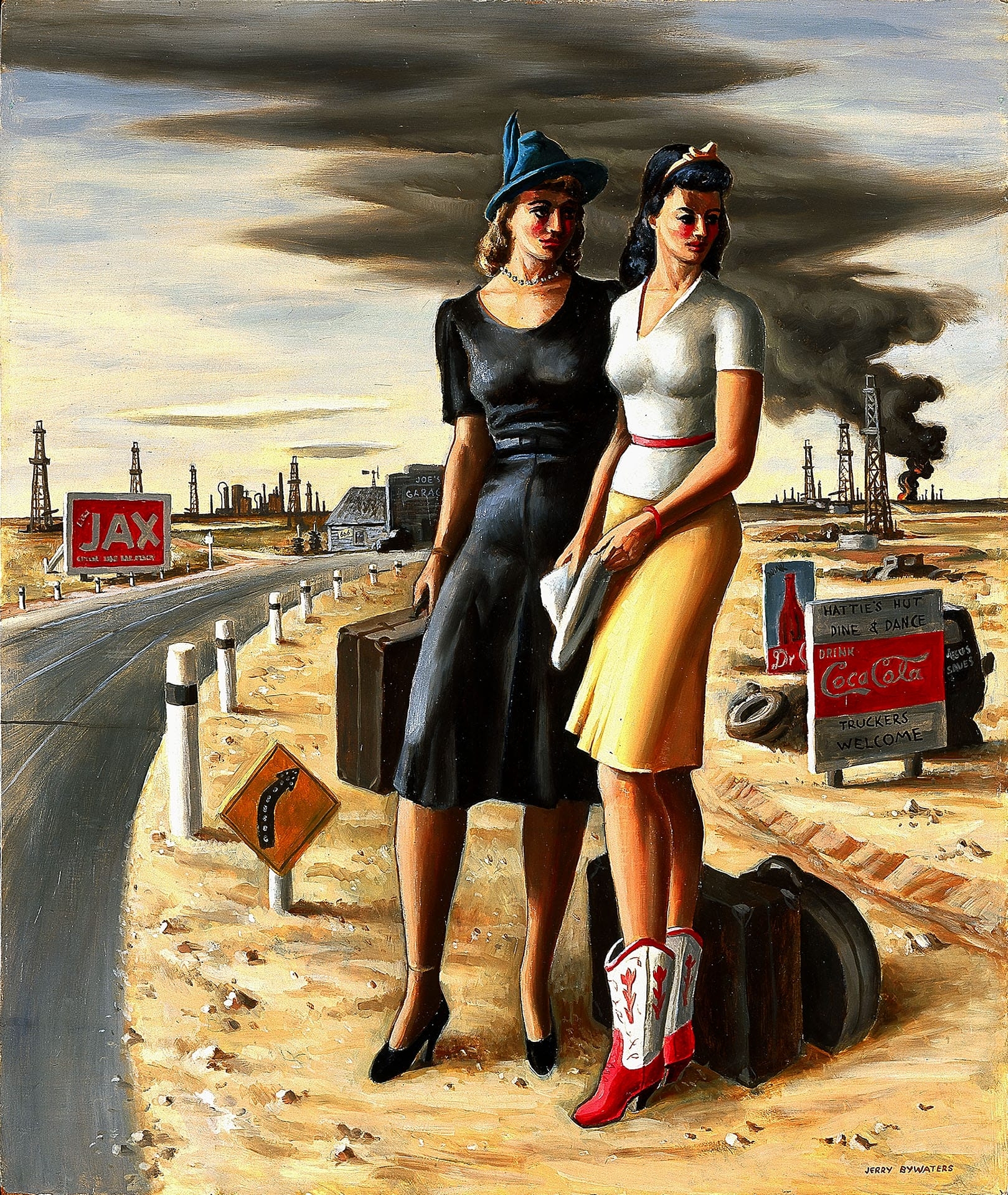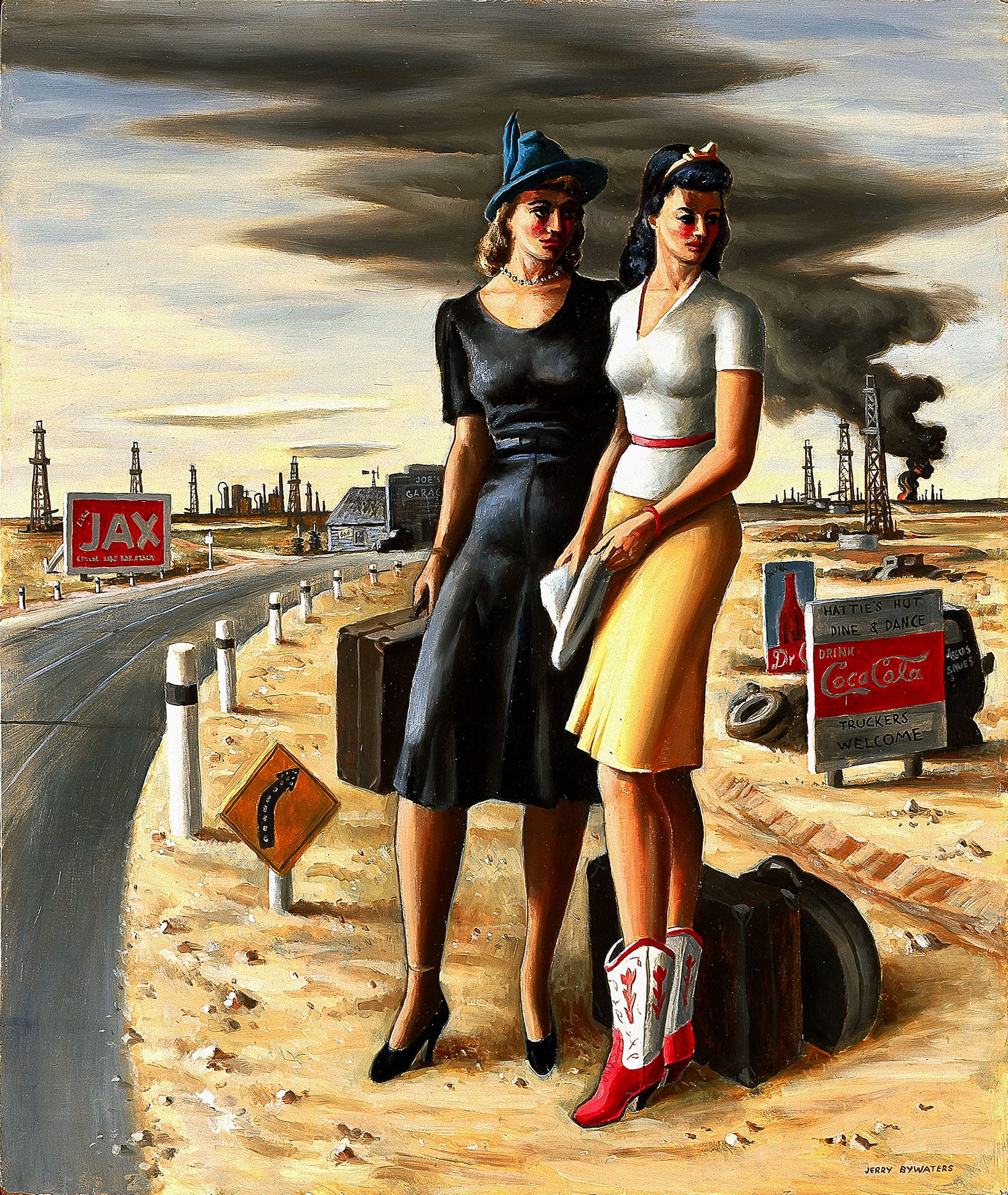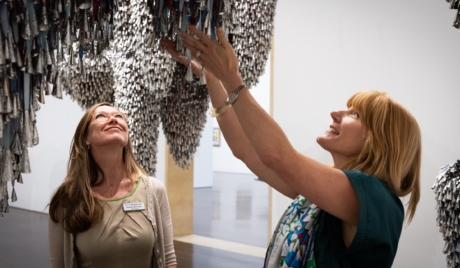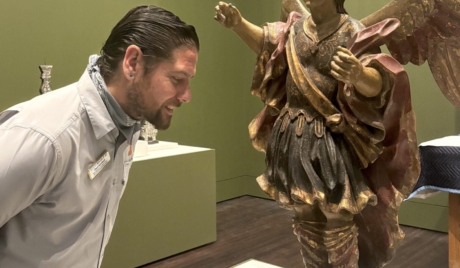
Decoding the Details: Oil Field Girls
Decoding the Details: Oil Field Girls
by Sarah Celentano, 2014 Fall Marketing Intern, Blanton Museum of Art

Decoding the Details is a four-part blog series investigating works in the Blanton’s permanent collection. Each post will focus on a single work of art and explore the importance of details that many might not notice at first glance. When we delve into an object’s unassuming elements or look beyond what is immediately apparent, we often discover something unexpected and come away with a greater connection to both the work and the world from which it came.
Sarah Celentano is the fall 2014 PR & Marketing intern at the Blanton. She is also a doctoral candidate in the Department of Art & Art History and specializes in the art of the Middle Ages. In the second post for her blog series, she takes a close look at Jerry Bywaters’s Oil Field Girls, on view in the Blanton’s galleries.
Jerry Bywaters’s Oil Field Girls is a work of incredible moral complexity. We see two women standing on the roadside. One wears a black dress that clings to her body. Her black heels, necklace, and the feathered hat covering her blonde hair suggest a life of luxury, but her situation tells us otherwise. Her companion appears more demure, with a bow in her dark hair and wearing a yellow skirt and a belted white blouse. The red of her belt is picked up in the bracelet at her right wrist and her western-style boots. She holds her white hat in her hands, and we notice a suitcase and hatbox at her feet. Upon closer inspection, we see that both women have brightly painted cheeks and lips, and heavily made-up eyes. Their exaggeratedly long legs and tightly fitting clothing give them an imposing presence.
Many scholars believe that the women are meant to be prostitutes. But if this is the case, Bywaters reserves judgment. He presents the women as a fascinating convergence of power, drive, and desperation. In fact, Bywaters himself said that he intended to create a work of “sympathetic caricature.” The women look into the distance in anticipation, waiting for someone, or anyone, to take them away from where they currently are. Once we look at the landscape, we can see why: pulling our gaze down the winding road are white posts and a traffic sign warning us of a curve ahead (perhaps one of many “dangerous curves” depicted here). We move past a sign for Jax beer, the ramshackle Joe’s Garage, and ultimately into burning oil fields where a growing plume of smoke stretches across the sky and behind the women’s heads, acting as a frame.
Some of us may have found ourselves on desolate roads much like the one depicted here. Bywaters in fact developed his idea for this painting while driving through West Texas. Yet, embedded in the recognizable landscape are symbolic elements that infuse the scene with additional meaning: on the left side of the road, hanging on the storefront of Joe’s Garage is a sign that reads “666,” a number often associated with demonic forces. Among discarded tires on the far right side of the painting is an abandoned piece of machinery with “Jesus Saves” scrawled across it, barely visible behind a sign for Hattie’s Hut, a honky-tonk where truckers are invited to enjoy the “dine and dance” on offer.
What are we to make of these contrasting references to heaven and hell? Is Bywaters commenting on the irony of industrialism? How the hellishness of the oil fields coexists with messages of Christian morality? That people eagerly await the Last Judgment as the sky above them burns? What role do the two women have here? Does the stark contrast of their clothing—dark on the left, light on the right—serve as an additional sign of the opposing forces at play? It is interesting that they are looking for travelers headed towards the oil fields—and therefore towards 666—intentionally moving beyond any hope of being saved. They seem to stand at the mouth of hell, waiting for a traveler to take them past salvation to the point of no return. That “Jesus Saves” is so obscured by a honky-tonk sign perhaps suggests that such promises of deliverance are overpowered by a new message of materialism in the wake of the Texas oil boom, illustrated by the billboards that have sprouted along the roadside.
When we delve into the details of Bywaters’s painting, we see that his landscape is as much a character as the two women. The natural world “speaks” in this work, telling us of a land altered by industry and the courage of those who would enter such a place. The two women, giantesses on the West Texas roadside, perhaps symbolize the spirit needed under such new circumstances. In abandoning the gentle comforts of traditional life, where Jesus saves, and choosing to venture into the unknown, where potential encounters with darker forces await, they demonstrate the resilience and sheer nerve required to survive in a transformed world.
Bibliography
Francine Carraro. Jerry Bywaters: A Life in Art. Austin: University of Texas
Press, 1994.
Jerry Bywaters. Letter to Tammy Fuller Gest. 14 December 1984.



